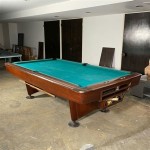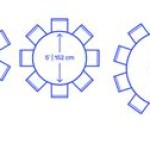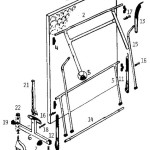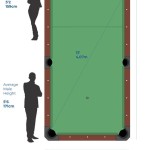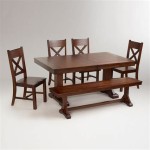Antique Drop Leaf Side Tables: A History and Practical Guide
Antique drop leaf side tables represent a significant category within antique furniture, offering a blend of functionality and aesthetic appeal that has resonated across centuries. These tables, characterized by their hinged leaves that can be raised or lowered to expand or contract the tabletop surface, have adapted to diverse needs and styles throughout their history. Understanding the nuances of their construction, design evolution, and value assessment requires a comprehensive approach, encompassing historical context, craftsmanship analysis, and market awareness.
The origins of the drop leaf table can be traced back to the 16th and 17th centuries, with early examples found in English and European furniture. These early forms were often relatively simple in design, constructed from solid hardwoods like oak and walnut. The primary purpose of the drop leaf was to provide a surface that could be expanded for dining or games and then folded away to conserve space in smaller homes. The leaves were typically supported by hinged brackets or "gates" that swung out to provide stability. These early tables often featured turned legs and minimal ornamentation, reflecting the practical needs of the time.
As furniture design evolved, so too did the drop leaf table. The 18th century witnessed a refinement in design, with the introduction of more elegant shapes, finer woods like mahogany, and more elaborate decorative elements. The influence of cabinetmakers like Thomas Chippendale and his contemporaries is evident in the more sophisticated drop leaf tables produced during this period. Cabriole legs, pad feet, and intricate inlay work became common features. Furthermore, the introduction of the Pembroke table, a specific type of drop leaf table with drawers and often a shaped top, added another dimension to the category.
The 19th century saw a further diversification of drop leaf table styles. The Victorian era, with its emphasis on ornamentation and eclecticism, produced drop leaf tables in a wide variety of forms, ranging from heavily carved and embellished pieces to more restrained and functional designs. Mass production techniques also began to impact furniture making, although hand-crafted examples continued to be produced. Different wood types were used, including rosewood, walnut, and various fruitwoods. The size and function of the tables also varied, with some designed for use as side tables, while others served as small dining tables or work tables.
The 20th century brought a renewed appreciation for earlier styles, and antique drop leaf tables became increasingly sought after by collectors and homeowners. The Arts and Crafts movement, with its emphasis on handcrafted quality and simple designs, also influenced the production of new drop leaf tables. Today, antique drop leaf tables remain popular for their versatility, portability, and aesthetic appeal, fitting seamlessly into both traditional and contemporary interiors.
Identifying Key Features and Styles
Accurate identification of an antique drop leaf side table requires careful observation and attention to detail. Several key features and stylistic elements can help determine the age, origin, and value of a particular piece.
Wood Type: The type of wood used in the construction of a drop leaf table is a primary indicator of its age and origin. Oak was commonly used in earlier English examples, while mahogany became popular in the 18th century. Walnut, cherry, and other fruitwoods were also used, particularly in American furniture. The grain and color of the wood can also provide clues. For example, highly figured mahogany is often indicative of high-quality craftsmanship and a higher value.
Leg Style: The design of the legs is another crucial element in identifying and dating a drop leaf table. Queen Anne cabriole legs, with their elegant curves and pad feet, are characteristic of the early to mid-18th century. Straight, tapered legs are more common in later 18th and early 19th century designs. Turned legs, often with decorative carving, were used throughout various periods. The presence of stretchers, which are horizontal supports connecting the legs, can also provide clues about the table's age and construction.
Hardware and Hinges: The type of hardware used, including hinges, locks, and drawer pulls, can be valuable indicators of age and authenticity. Hand-forged hinges, often with irregular shapes and marks, are typical of earlier examples. Later tables may feature machine-made hardware. The style of drawer pulls can also be informative, with different styles being popular in different periods. Examining the hardware for signs of wear and replacement is also important.
Construction Techniques: Examining the construction techniques used to build the table can reveal important information about its age and craftsmanship. Hand-dovetailed drawers, for example, are indicative of earlier, hand-crafted construction. Machine-cut dovetails are characteristic of later, mass-produced pieces. The way the leaves are attached to the table, and the type of support used (e.g., gate leg, butterfly support), can also provide clues about the table's age and style.
Style and Ornamentation: The overall style and ornamentation of the table are essential for identification. Elements such as carving, inlay, and veneers can help determine the period and region of origin. Queen Anne, Chippendale, Hepplewhite, and Sheraton are just a few of the stylistic influences that can be observed in antique drop leaf tables. Understanding the characteristics of each style is crucial for accurate identification.
Assessing Condition and Value
Determining the condition and value of an antique drop leaf side table requires a thorough assessment of its physical state, originality, and historical significance. Several factors contribute to its overall worth.
Structural Integrity: The structural integrity of the table is paramount. Check for any signs of weakness, such as loose joints, warped surfaces, or cracked legs. A table that is structurally unsound will require restoration and may be less valuable. Gently test the stability of the table and its leaves to ensure they are secure and function properly.
Originality: Originality is a key factor in determining the value of an antique piece. A table that retains its original hardware, finish, and components is generally more valuable than one that has been heavily restored or altered. Look for signs of replacement parts or refinishing, as these can detract from the table's value. However, sympathetic restoration, aimed at preserving the original character of the piece, can sometimes enhance its value.
Finish: The finish of the table is another important aspect to consider. An original finish, even if worn, is often more desirable than a new finish, as it provides evidence of the table's age and history. However, a badly damaged or deteriorated finish may detract from the table's value. A professional cleaning and waxing can often improve the appearance of the finish without compromising its originality.
Damage and Repairs: Carefully examine the table for any signs of damage, such as scratches, dents, stains, or water marks. Major damage can significantly reduce the value of the table, while minor imperfections may be acceptable or even desirable, as they contribute to its character. Assess the quality of any previous repairs. Poorly executed repairs can detract from the value, while well-executed repairs can improve the table's appearance and stability.
Rarity and Desirability: The rarity and desirability of a particular style or type of drop leaf table will also influence its value. Tables from well-known makers or those with unique features are generally more valuable than more common examples. Market trends and collector preferences can also impact the demand for certain styles.
Caring for Antique Drop Leaf Side Tables
Proper care and maintenance are essential for preserving the beauty and value of antique drop leaf side tables. Following these guidelines will help ensure the longevity of these historical pieces.
Cleaning: Regular dusting with a soft, lint-free cloth is crucial for preventing the build-up of dirt and grime. Avoid using harsh chemicals or abrasive cleaners, as these can damage the finish. For more thorough cleaning, use a slightly damp cloth with a mild soap solution, followed by a dry cloth to remove any excess moisture. Avoid using excessive water, as this can damage the wood.
Polishing and Waxing: Periodically polishing or waxing the table can help protect the finish and enhance its luster. Use a high-quality furniture polish or wax specifically designed for antique furniture. Apply the polish or wax sparingly, following the manufacturer's instructions. Buff gently with a soft cloth to achieve a smooth, even finish.
Environmental Control: Maintaining a stable environment is essential for preserving antique furniture. Avoid placing drop leaf tables in direct sunlight or near sources of heat, as these can cause the wood to dry out and crack. Maintain a consistent humidity level in the room to prevent warping and other damage. A humidifier or dehumidifier may be necessary to regulate humidity levels.
Handling and Support: Handle antique drop leaf tables with care to avoid damage. When moving the table, lift it rather than dragging it. Ensure that the leaves are properly supported when they are extended. Consider using felt pads under the legs to protect floors from scratches.
Professional Restoration: If the table requires significant repairs or restoration, it is best to consult a professional furniture restorer. A qualified restorer will have the knowledge and skills necessary to repair the table properly while preserving its original character and value. Avoid attempting to repair the table yourself unless you have the necessary experience and expertise.

Victorian Oak Corner Table Art Nouveau Drop Leaf Folding Side

Drop Leaf Side Table Makeover Confessions Of A Serial Do It Yourselfer

Awesome Petite Vintage American Drop Leaf Side Or End Table Antique Tables

135 Antique Drop Leaf Tables For Ingantiques Co

Antique Drop Leaf End Table Painted Accent

Small English 1880 Oak Drop Leaf Side Table With Turned Legs And Stretchers For At 1stdibs End Antique Tables

Antique Dropleaf Tables

Antique Mahogany Drop Leaf Table

Sold At Auction Diminutive Antique Drop Leaf Side Table

Antique Sutherland Drop Leaf Side Table 1880s For At Pamono

